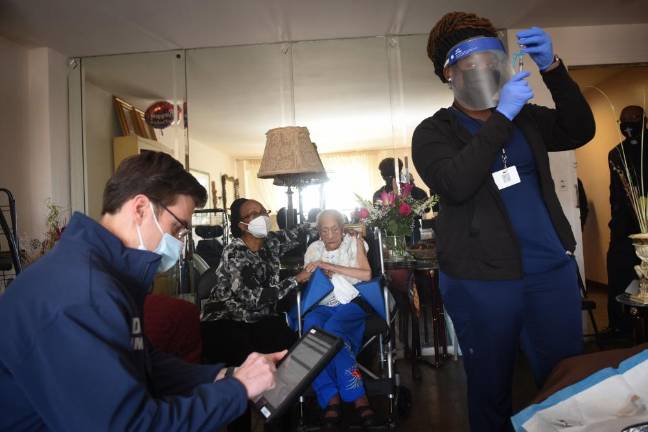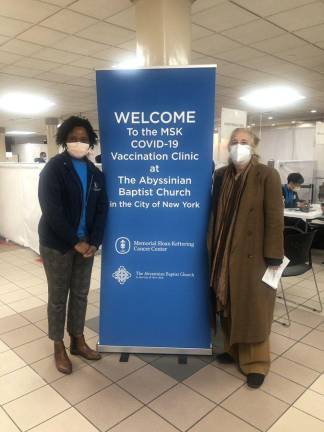A Tangled Vaccine Web
Manhattan Borough President Gale Brewer offers a vaccination site checklist to help New Yorkers navigate the system


Gale Brewer distributed a remarkable list last Friday. It was not your typical shopping list or to-do list. This was a list of every website you could click to, every phone number you could call, every aggregator you could check and every address you might just be able to walk into to get a COVID-19 vaccine in Manhattan.
“Getting a vaccine is getting easier as the supply expands - but it’s far from streamlined,” Brewer, who is the Manhattan borough president, said diplomatically. “I’ve compiled this checklist (also accessible on my website) to help you know about every possible option.”
There were more than 30 such options on her checklist. So this was both a service to the community and a quiet witnessing to the tangled web of the greatest mass vaccination in New York at least since the smallpox drive of 1948.
The problem with this complexity, beyond its obvious aggravations, is that the standard for whether you get the vaccine becomes your ability to navigate the system not whether you are at the greatest risk of getting or spreading the coronavirus.
In other words, our jabs are not going to where they would be sent by a system designed purely to achieve the best public health outcomes.
There are many ways to illustrate this disparity. Mark Siddall, an expert on eradicating infectious diseases, posted a neighborhood map of the city showing that the rate at which residents are being vaccinated seems to be inverse to where people have been dying. That is, higher death rate, lower vaccination rate.
Just comparing City Health Department data on Manhattan neighborhoods, East Harlem (10029) has a death rate from COVID-19 of 341 per 100,000 residents and 184 new cases where identified in the week to April 6. In Lenox Hill (10021) on the East Side, the death rate was 183 per 100,000 and there were 29 new cases.
In Lenox Hill, 60 percent of the residents have received at least a first dose of vaccine and 45 percent are fully vaccinated, according to the city data. In East Harlem, only 38 percent have received a first dose and 25 percent are fully vaccinated.
Unintended Downsides
Siddall noted that even some of the well-intentioned efforts to improve vaccine access may have unintended downsides.
For example, one of the services Brewer listed is called TurboVax, which explains that it is “a Twitter bot (@turbovax) that tweets the latest NYC vaccine appointments.” This is a service invented by a software developer at Airbnb named Huge Ma, who was frustrated when he couldn’t make an appointment for his mother through existing city and state websites.
Ma was honored April 6 by Andrew Yang, the mayoral candidate, who convinced Ma to make his first public appearance of the pandemic. “I just wanted to make the vaccine process simpler,” Ma said, while standing in front of the Fort Washington Armory vaccination center. “That’s it.”
On the promise that reporters weren’t joining them, Ma then went to lunch with Yang but stressed he was not endorsing him.
Siddall pointed out that TurboVax, whatever its merits, didn’t solve the problem that to make an appointment you still needed internet access, or at least a son who was a software developer. In fairness, as Siddall noted in an email, Turbovax didn’t create the vaccine inequities, although it may exacerbate them if Turbovax helps the digitally enabled to snag appointments away from local residents who should be the priority.
Siddall praised the way the vaccine site at Fort Washington Armory has been setting aside 60% of its appointments for residents of Harlem and Northern Manhattan.
Of course, improving access to appointments, as important as that is, doesn’t solve everything for working New Yorkers who are juggling three gigs to get by and may not be certain when they will be available for a shot and a booster weeks into the future.
Siddall’s own experience illustrates how challenging vaccine access continues to be. “So I just got my first shot of the Pfizer vax,” he wrote Saturday. “I was only able to get an appointment in my ‘hood (I am 10033) by going on to the CVS site at 1 second after midnight on Tuesday. And even then, the first 3 appointments I tried for this morning failed.”
When he arrived Saturday at the CVS on Dyckman St. in Inwood, “there wasn’t a single person of color. Not one African American or Hispanic person in line to get vaccinated. Plenty of African American & Hispanic people in the store. The person in front of me was from Brooklyn, the person behind me was from Midtown, the person behind her was from Long Island City. Every one of us had used on-line resources, and strategized to get our appointments.”
Energetic Showings
Governor Andrew Cuomo and Mayor Bill de Blasio both made energetic showings last week of their efforts to get vaccines to those who need them most, as if they were determined to break through the inequtiies of the systems their own governments had created and presided over.
Four months after the start of vaccination efforts, Mayor de Blasio announced with some fanfare the deployment of mobile vaccination vans, leaving many public health experts puzzled over why the city had not done this sooner given the city’s considerable history of using mobile clinics to address other community health issues.
The mayor’s office said the vans were “made possible” by the one dose Johnson & Johnson vaccine, which eases the challenge of scheduling two appointments. Using the one dose jab, the city also announced it was dramatically expanding sites were seniors 75 and over could simply walk in and get vaccinated, including these in Manhattan:
*Essex Crossing
*City College
*Abyssinian Baptist Church
*Ford Foundation
*Yeshiva University
*Fulton Community Center
The first mobile van, given the specific mission of reaching restaurant and food delivery workers, was dispatched first to Sunset park (11220) in Brooklyn, where there have been 336 new Covid-19 cases in the past week, highest in the city. Only about 22 percent of residents there are fully vaccinated, so far, and 41 percent have received at least a first dose.
“We’re continuing to adapt and expand our efforts,” Deputy Mayor for Health and Human Services Melanie Hartzog, “and addressing hesitancy by making the vaccine as accessible as possible.”
While the mayor was focused on mobile vaccination efforts, the governor was touting pop up clinics and his “roll up your sleeve” campaign on a visit to Rochdale Village, the overwhelmingly black community just north of Kennedy Airport in Queens.
In and around Rochdale Village (11434) there have been 126 new cases of COVID-19 in the past week. Only 27 percent percent of local residents have received even a first dose of vaccine and 18% have been fully vaccinated.
“We are doing everything we can to do this equitably and fair,” Cuomo told a gathering of supporters who resembled a political pep rally more than a public health briefing. “We are bringing the vaccines to the Black community, to the Latino community, 189 popup vaccine sites in communities of color.”